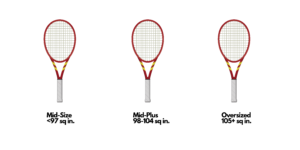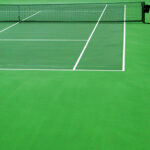Picking the right best tennis racket is crucial for your performance on the court. The choice comes down to key factors such as skill level, head size, weight, balance, and string pattern. Understanding these will help you find a racket that matches your playing style and enhances your abilities.
1. Skill Level
Your skill level is the most important factor in selecting a racket:
- Beginners: Look for a racket with a large head size (100+ sq inches) and lightweight frame. This combination offers more power and a larger sweet spot, making it easier to hit clean shots.
- Intermediate: A medium head size (98-100 sq inches) with a balanced weight will provide a good mix of power and control, helping you refine your game.
- Advanced: Advanced players often prefer smaller head sizes (85-97 sq inches) for more control and precision, as they can generate their own power
2. Head Size: Power vs. Control
Racket head size is key to determining power and control. Here are the three common categories:
- Midsize (85-97 sq inches): Offers the most control but requires precision. Advanced players use these rackets for better shot placement, with less margin for error.
- Midplus (98-104 sq inches): The most popular size, offering a balance of power and control. Suitable for intermediate to advanced players, it provides a solid mix of power and precision.
- Oversized (105+ sq inches): These rackets offer maximum power and a large sweet spot, making them ideal for beginners or players needing more forgiveness on off-center hits.
3. Weight: Maneuverability vs. Power
The weight of a racket influences your swing and overall comfort:
- Lightweight (9-10.5 oz): Easier to maneuver and swing, ideal for beginners or players who prefer speed over power.
- Heavier (10.5+ oz): Offers more stability and power but requires more strength to swing. Advanced players benefit from the added control and ability to handle fast, powerful shots.
4. Balance: Stability and Swing Speed
Racket balance is another critical factor in determining how it performs during play:
- Head-Heavy: These rackets generate more power, especially from the baseline, but can feel less maneuverable at the net.
- Head-Light: Provides better control and faster swing speeds, which is great for players who enjoy serving and volleying or who need quick reactions.
5. String Pattern: Spin or Precision
The string pattern of a racket affects how much spin or control you can get:
- Open String Pattern (16×19): More spin and power are possible due to the larger gaps between strings.
- Dense String Pattern (18×20): Provides more control, which is beneficial for players who prioritize precision and placement over spin.
Popular Tennis Rackets Based on Style and Skill Level
For Beginners
- Wilson Clash 108
- Specs: 108 sq inches head, lightweight, head-heavy balance
- Why it’s great: Large head size for easy power generation and forgiving on mishits, ideal for beginners learning the game.
- Babolat Boost Drive
- Specs: 105 sq inches head, 9.8 oz, open string pattern
- Why it’s great: A great option for those starting out, offering additional power and spin without sacrificing comfort.
For Intermediate Players
- Yonex EZone 100
- Specs: 100 sq inches head, 10.6 oz, open string pattern
- Why it’s great: Offers a perfect balance of power and control, ideal for players refining their skills and looking for versatile performance.
- Head Graphene 360+ Speed MP
- Specs: 100 sq inches head, 10.6 oz, head-light balance
- Why it’s great: Ideal for intermediate players looking to transition into more advanced control-focused play, while maintaining some power.
For Advanced Players
- Wilson Pro Staff RF97 Autograph
- Specs: 97 sq inches head, 12.5 oz, head-light balance
- Why it’s great: Designed for maximum control, precision, and stability, this racket is a favorite of professional players.
- Babolat Pure Strike 98
- Specs: 98 sq inches head, 10.8 oz, dense string pattern
- Why it’s great: Offers precision and responsiveness, making it perfect for aggressive advanced players who demand control and sharp shot placement.
Final Thoughts
Choosing the right tennis racket is about understanding your style, needs, and skill level. Consider the head size, weight, balance, and string pattern to find the racket that will complement your game. Whether you’re starting out or refining advanced skills, selecting the right racket will help you maximize your performance and enjoyment on the court.









